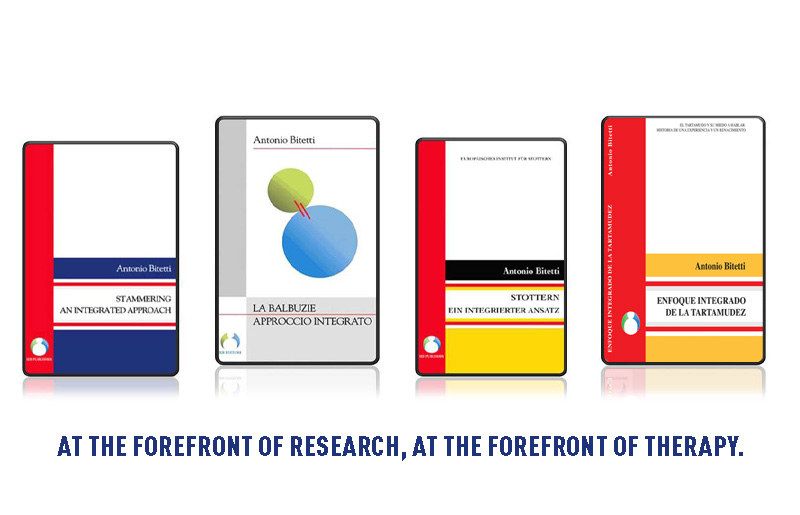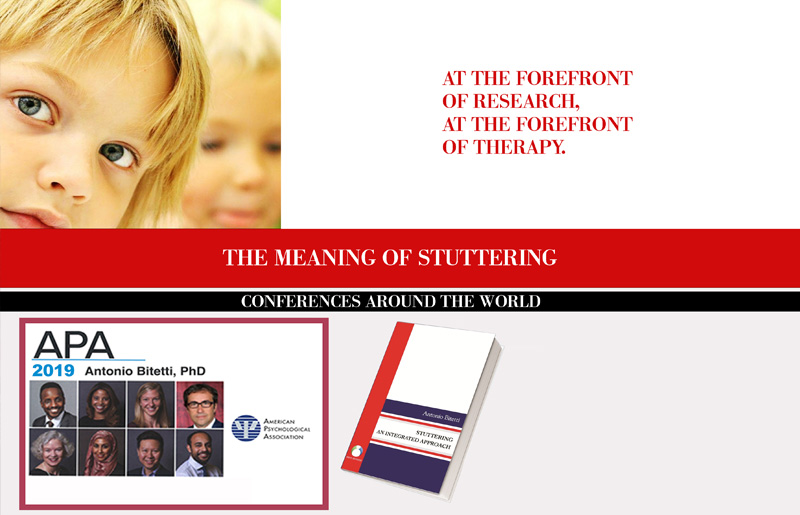Radio interview on stuttering on Rete Due RSI-CH of Lugano
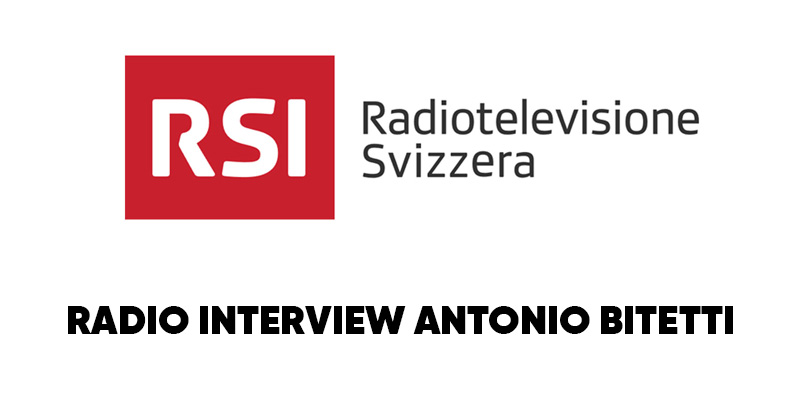
On October 22, 2024, on the occasion of World Stuttering Awareness Day, Dr. Antonio Bitetti gave a radio interview on the topic of stuttering on the radio della Svizzera Italiana in Lugano, Canton Ticino. The presenter Marco Pagani gave a brief introduction to the problem, also pausing to list the statistics of the World Health Organization (WHO) and recalling the famous film dedicated to King George VI, “The King’s Speech” affected by stuttering and well interpreted by the actor Colin Firth. Immediately after, Dr. Bitetti illustrated his point of view on this topic which has always been identified as a language problem. In truth, it is not because there is clear evidence that the stutterer knows how to express his language very well, but only in a context isolated from people. Unfortunately, the dominant culture believes that stuttering is a language problem and everyone is trying to cure it with re-educational, phonetic and/or speech therapy methods, leaving aside the internal matrix of the problem. The presenter was quite surprised by Dr. Bitetti’s statements and understood the interpretative message regarding the emotional and relational implications of stuttering, greatly appreciating the description given by Dr. Bitetti in this interview. The time is now ripe to decide to affirm that stuttering is not a language problem at all and also in the international therapeutic scenario the therapeutic model proposed by Dr. Antonio Bitetti should take hold, with his: Integrated Approach. This therapeutic model, now known throughout Italy, addresses stuttering even at an early age, on disfluent children aged between 2 and 5 years, intervening on the parents to avoid the chronicization of the problem and obtaining truly interesting results.
Stuttering Therapy in Adults
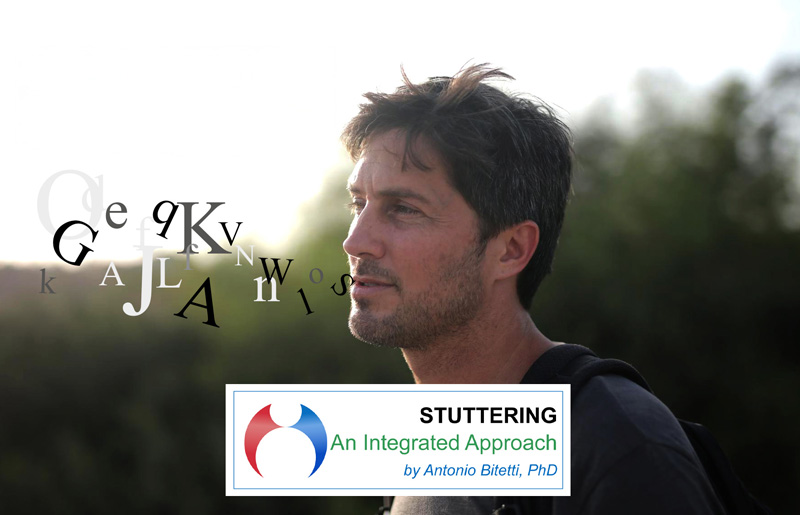
The stutterer constantly experiences the problem of saying, not saying, there is not that spontaneity typical of the normoloquent, that is, of someone who speaks without any verbal hitches. The treatment of stuttering in adults requires an Integrated Approach to the problem. For a long time, the problem of stuttering has been ironized and in very distant times there was a tendency to associate the difficulty of speaking with an intellectual delay. The fluency of language is hindered, but not the intelligence and the ability to complete one’s own projects. On a cognitive level, however, the stutterer is constantly influenced by a type of thinking, where the fundamental element is the control of the word1. Stuttering in Adults: the result of wrong methods Usually, the adult stutterer has already done speech therapy cycles and courses on stuttering as a child, based mainly on phonation or similar techniques, accompanied by breathing exercises. However, few adult stutterers have addressed the deeper aspects of their stuttering and find themselves with an unchanged, or slightly improved, situation, at least in terms of language. In fact, it often happens that after several cycles of re-education sessions with treatment methods based on improvised intuitions, the adult stutterer often returns to his old habits. Fear of Stuttering: between states of anxiety and desire to relate The fear of stuttering leads to a constant focus on how to speak, rather than focusing on realistic and logical factors, that is, what you want to say. With such a sequence of thoughts it is easy to fall into a state of anxiety that compromises speech itself. The normal speaker, on the contrary, does not control his words, they are fluid, he is more attentive to what he says, than to how. Through the Integrated Approach, his method of treating stuttering, Dr. Antonio Bitetti addresses the difficulties of the adult stutterer from different points of view, focusing especially on relational dynamics. These dynamics explain one of the character traits of the adult stutterer: passivity. It is understood as a subtle fear on the part of the stutterer to bring out all the underlying energy that he has always held back. A passivity that leads him to give up various social and relational activities. Not only that, this holding back of energy often has repercussions on the emotional sphere, and it is easy to find stuttering adults who are emotionally isolated. The patient brings with him many painful experiences, made of sacrifices, humiliations and often imbued with feelings of social isolation, loneliness and even anger. This is why the stuttering adult is constantly looking for interpersonal relationships with other stutterers. He feels more reassured by his peers, he feels protected and not judged. This explains the continuous search for methods of treating stuttering that are based on support techniques, using the group as a basis for therapeutic work. However, this does not mean that stuttering is actually being treated, but rather that the symptomatic aspect is simply being treated. Indeed, it is important to emphasize that through interacting with other people affected by the same problem, the patient receives a pleasant sensation, as if they were actually making progress, but the truth is that the fear of speaking in front of others is inhibited by the fact that others share the same disorder as the speaker. Therefore, it is not an effective resolution of the problem. The emotional dynamics behind adult stuttering Stuttering therapy in adults opens up a fascinating world of emotional dynamics in the stutterer. The stutterer constantly experiences the problem of saying, not saying, there is no spontaneity typical of the normal speaker, that is, of someone who speaks without any verbal hitches. The stutterer finds it more difficult when he has to verbalize thoughts with high emotional content, or when he has to present a topic in front of several people, especially if they are considered authoritative, or that he considers such. This suggests the presence of complex psychological mechanisms, which have fueled the scientific literature on the etiopathogenesis of this disorder. In general case studies, it is found that almost all stutterers stutter in the presence of strangers, or those considered important. The example of the adult who has to take a job interview, or who has to present a report in front of a multitude of people, is emblematic. On a relational level, the stutterer feels like a prisoner of his disorder and experiences social relationships with difficulty and suffering. For example, he fears verbal exposure in any group relationship, feels uncomfortable and embarrassed if he is asked to repeat a topic already exposed, and experiences his difficult moment on the phone, which becomes a painful experience and even a real block. This does not mean that all stutterers have social limitations, it depends on the severity and importance that the stutterer gives to his disorder. In fact, a fundamental element is given by the negative perception of oneself, and by the feared negative judgment by others, which can increase the level of anxiety, and thus affect normal social relationships. This brief exposition of the difficulties that the adult stutterer experiences, leads to reflections on the psychic dynamism underlying the disorder. How to Stop Stuttering Forever: Integrated Approach A true cure for adult stuttering must include a significant restructuring of the stutterer’s personality. The Integrated Approach in adults with stuttering addresses the deepest elements of stuttering. It is not a psychoanalytic therapy and it is not a cognitive behavioral therapy in the most classic definition. It is a comprehensive approach to stuttering, the result of over twenty years of studies and research in the specific sector. For all adult stutterers who have entrusted themselves to the care of Dr. Bitetti, after having undergone therapies in other fields, the Integrated Approach turns out to be a complete therapy. Complete, because it does not leave out any aspect, it goes in the right direction to offer the adult stutterer all the tools
Childhood stuttering

The main classification of childhood stuttering is the one that divides this disorder into primary stuttering and secondary stuttering. This classification takes into account the time of onset of the disorder and the characteristics of the disorder itself. The classification of childhood stuttering The main classification of childhood stuttering is the one that divides this disorder into primary stuttering and secondary stuttering. This classification takes into account the time of onset of the disorder and the characteristics of the disorder itself. Primary stuttering (also known as running-in stuttering or pseudo-stuttering) is a fairly common disorder; it is estimated, in fact, that the problem affects 30% of infants, especially males; primary stuttering usually disappears spontaneously without the need for speech therapy or language rehabilitation. Secondary stuttering (also called true stuttering) is a much more serious problem than primary stuttering. It usually manifests itself in that period of life that goes from the age of 6 to 14. It is very unlikely (although not impossible) that true stuttering manifests itself in adulthood. THE MAIN SYMPTOMS OF CHILDHOOD STUTTERING Repetitions of syllables or consonants such as pa-pa-pa-pane or ppppp-pappa, often accompanied by a blockage in the flow of air, which some confuse with a possible breathing problem. Interiors as “um” “em”. Negativism: The child who stutters often presents a negative and repulsive attitude towards speaking. It is the result of repeated attempts to speak correctly and the frustration that comes from several failed attempts. Synkinesias and facial tics: childhood stuttering is often accompanied by facial expression mimics, or even convulsive body movements, called synkinesias. These, especially in tonic stuttering. Facial tension is the result of an extreme attempt by the child who stutters to find the energy and strength necessary to get the word out correctly. Circumlocutions: the stutterer tries to avoid his difficulty by replacing words that he perceives as difficult to pronounce with others that may be more facilitating. Physical Problems: Repeated attempts to speak fluently can cause several physical changes. The person may clench their jaw, hold their breath, and clench their fists. This, in turn, can cause muscle tension in the shoulders, limbs, and forehead. Childhood stuttering can represent a particular moment in the gradual acquisition of language which, as we know, usually occurs between 12 months and 3 years. In particular, the average age of onset of childhood stuttering is around 3 years of age. There is no need to worry if, at this stage, the child breaks up, repeats or prolongs the syllables that form words. For some authors, it may be a question of more or less typical disfluencies. In 4 out of 5 cases, childhood stuttering resolves spontaneously, at most within 5 years from the moment of its onset and, in 75% of cases, even within the first 3 years. This does not change the fact that the phenomenon must be followed carefully and kept under careful observation from its first manifestations. Statistically, childhood stuttering is observed more frequently in males, and hence the tendency for some researchers to glimpse a strong heredity of the disorder, which in some cases can regress but reappear in adolescence. Even if the child has been stuttering for a year, it does not mean that the problem will persist. The disorder can regress spontaneously even 3-4 years after its onset. However, a lot can be done to alleviate it, or overcome it. For this reason, it is necessary to avoid what Dr. Antonio Bitetti explains in his work on prevention, that is, to absolutely avoid the problem becoming chronic and becoming a persistent and structured form. THE CURE FOR CHILDHOOD STUTTERING THE INTEGRATED APPROACH TO CHILDHOOD STUTTERING Childhood stuttering, on the other hand, represents an unsuccessful phase of this evolution, from stuttering to healthy and effective language. Important relational aspects can affect this developmental block. To avoid this risk of chronicity and therefore of stuttering, it is necessary to intervene early. Usually childhood stuttering, that is, stuttering in a child of 3-4 years or stuttering in a child under 5 years old, is usually not treated, we tend to wait for it to become chronic, to be sure that the symptoms are certain, on a safe diagnosis. Usually we tend to think that it can regress spontaneously. Dr. Antonio Bitetti has a different opinion. He has introduced an interesting therapeutic path, suitable for parents of children with stuttering of 3-4 years. Not only that, but also in 5-year-old children who still stutter and who present aspects susceptible to becoming elements of chronicity of the symptoms and therefore, of true stuttering. Pediatricians are cautious and wait-and-see, speech therapists give up because they do not have the right tools to deal with the initial aspects of childhood stuttering. The Integrated Approach to the symptoms of stuttering children aged 3-4 and 5 years, unlike the therapeutic model aimed at older patients, is focused on correcting mainly the parents’ attitudes, and is specifically addressed to them, without the child’s presence, to avoid unfounded fears. This work is based on intuitions and cutting-edge research into the causes of childhood stuttering. The intra-family communication dynamic is addressed and all those difficulties that Dr. Antonio Bitetti believes to be fundamental in clarifying the entire dynamic in question are corrected, to allow the child to recover that basic serenity, necessary to speak well and move away as soon as possible from the risk of it becoming a real stuttering. This important research by Dr. Bitetti on childhood stuttering, supported by testimonies of parents of children undergoing treatment, will be the subject of disclosure in some American scientific journals in the sector and will be part of a broader and more detailed research in his new book, which will be published in the coming months, in which the mechanism of control over speech and other similar disorders will be addressed (Bitetti A. La Balbuzie Approccio Integrato, Milan, 2010). It is serious research that promotes knowledge and frees us from fears. On this, Dr. Antonio Bitetti has always
Stuttering Therapy
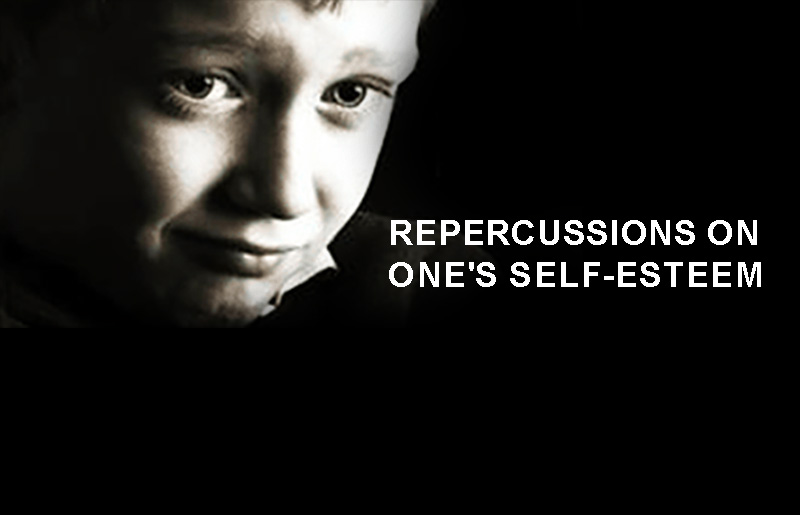
Stuttering therapy is an open field, where different interpretations of the same problem are compared and sometimes clash. In fact, even in the linguistic definition, many talk about stuttering and some persist in calling it stuttering. Some authors talk about a problem to be re-educated in language and others approach the problem from a strictly psychological point of view. Everyone unanimously agrees on a characteristic point of this disorder and that is: The stutterer knows very well what he wants to say, but is unable to express it in a fluid and serene way, as the vast majority of the population does. At this point, it is natural to ask why the stutterer has difficulty speaking when he relates to others, and instead does not stutter when he is alone. The answer cannot be simple and banal, since it involves those cognitive, emotional and relational aspects that language has in itself. We know that through language, human beings create connections, express emotions, ideas, projects and therefore, we all recognize the intrinsic value of this powerful tool. Language has a structural or genetic basis and an acquired basis, of a cultural or environmental type (Chomsky N.). In childhood, the child experiences an important phase in his delicate evolutionary period and is called the babbling phase, in which the child engages in the best possible research to converge structural aspects and cultural aspects. The same happens in walking, the child gradually learns to coordinate his movements, according to a series of trials and errors, also on the basis of a process of strengthening his own musculoskeletal system. Once he acquires the entire sequence, the child will be able to walk alone and without the help of adults. Language follows the same logic, but unlike motor activity, language has an important relational value, since through it we are able to express emotions, sometimes, in some negative or traumatic experiences, even with a strong aggressive value. This has pushed Dr. Bitetti to delve into the real reasons behind this widespread disorder, which, let us remember, affects 2-3% of the national population. In a recent interview he gave to a Spanish television station, the journalist recalled that in Spain there are at least 800,000 people affected by stuttering. In Italy, with a larger population than the Spanish one, we are in the order of a million people. Although, and it is appropriate to clarify, many statistics should be further investigated, since many forms of stuttering can be simple manifestations of lisping, mistaken for stuttering. Dr. Bitetti’s research Bitetti in the field of stuttering treatment, who is also the author of three books on stuttering (Bitetti A., 2001, 2006, 2010) the last one also translated into English and German, have focused on the mechanism of emotional control and in the case of those who suffer from stuttering, it becomes a control of the peripheral part of language, that is, the word. The vast majority of the population does not control the word while speaking, they know that it will be an automatic process, just as it happens in walking. No one would dream of controlling and verifying the movements of the legs during a walk or during a run, if we did, we would risk blocking ourselves or strongly conditioning the spontaneous activity. Therefore, control is the real negative element of those who stutter (A. Bitetti, Emotions, Behavior and Control, 2016) and it is an aspect learned as a child, in conjunction with events with a strong negative valence, such as the birth of a sibling, conflict between parents or different experiences in which frustration and consequent aggression predominate. If left free to consolidate, in the long run, the control mechanism can create a chronic disorder, commonly called stuttering. Treatment of stuttering in very young children. Dr. Bitetti has explained in various institutional contexts, such as the important congress of Phoniatrics and Speech Therapy, held in Bari in 1999, that stuttering represents an adaptive symptom at an age in which the child could not adequately manage an emotional turmoil that would have had greater repercussions in his psychic sphere. Only that not having received suitable therapy, the child (we are talking about children aged 2-5 years), remained imprisoned and made the whole dynamic in question become chronic. If kept active, this disorder risks compromising the normal relational and emotional growth of the child, to the point of making him acquire as an adult, what Dr. Bitetti defines: “the stutterer’s habit”. Stuttering, or rather stammering, in the initial stages is an adaptive mechanism that should be abandoned in a short time. evi, this is why it is necessary to intervene early, especially before the adolescent period, even better before it becomes definitively chronic. This is why Dr. Antonio Bitetti has extended his model of care intervention also in a preventive manner, in those children under 4-5 years of age, who have maintained active stuttering, but cannot be defined as stuttering children. This extension of his Integrated Approach is an achievement and an absolute novelty in the national panorama and is aimed at parents who would like to intervene quickly, but do not receive adequate responses from any area in Italy.
Psychological meaning of stuttering
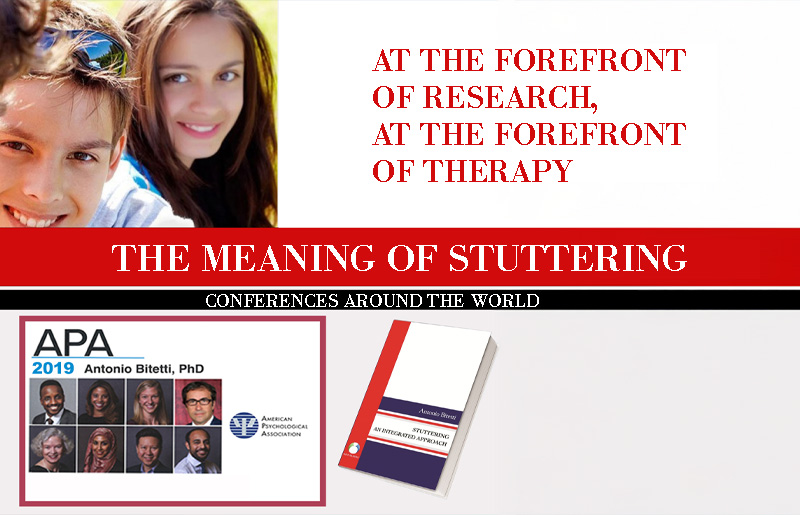
In my research on the deep meaning of stuttering, I am going to give a further contribution to the understanding of this disorder, especially in terms of analysis of the phenomenon of stuttering in a linguistic and relational sense. After an interesting journey of analysis of the problem and after having treated thousands of stuttering children and adults, I am about to take a further step forward in explaining what, in my opinion, could be the psychological meaning of the problem. My experience of group analysis to treat my stuttering and to train as a psychotherapist has been enlightening in giving me those ideas for reflection to better understand stuttering. Above all, its psychological and evolutionary meaning, within the mechanisms of language acquisition in children first and then in adults. Furthermore, the relational use that is made of the word in the processes of social integration within the social group. Joseph Sheehan compared stuttering to an iceberg, with the obvious aspects of stuttering positioned above the water level and the larger mass of negative emotions not visible, placed below the water level. This definition is similar to what I describe in the concept of the two areas within the personality of each of us, in which the negative component of the stutterer has a clear predominance over the positive one. Only the topical aspect of the dynamism in question changes. While Sheehan thinks of a concept more oriented to a level study, I go in the direction of the comparison between areas of the personality, with the substantial prevalence of one area over the other. THE MEANING OF THE SYMPTOM STUTTERING Now, beyond Sheehan’s concept of a great importance of the submerged part that forcefully affects the emerged one, I want to better explore the meaning of the symptom of stuttering. It is almost certain that the ancients, hearing a stutterer speak, thought of a person who spoke a language different from theirs. This is why the term stutterer derives etymologically from Balbus. This term refers to the concept of “barbarian” that in ancient times was used to define someone who spoke a language different from the reference group. In fact, the stutterer through his disarticulated language pushes us to believe that this is true. But, it is always necessary to point out, the stutterer when he is alone returns to being a person with shared language. At this point, the crucial question obviously arises as to why the stutterer uses this disarticulation during the comparison with others and returns to normality, in the calm condition of when he is alone. In my long research on stuttering, I see a defensive reasoning that the stutterer uses in his relational dynamics. A disjointed language learned in childhood to confuse and be confused by a situation that the child has experienced as unsustainable, where negative emotions, especially anger, have certainly prevailed. A strange language to divert attention from an experience that is not easily manageable and with uncertain outcomes. By choosing to stutter, he has chosen a more practical solution. Then, the symptom has generated reassurance in the short term and habit in the long term, until it has become what I call “the stutterer’s habit”. (Bitetti A., Stuttering An Integrated Approach, IEB Editore, Milan, 2016) amazon.com/author/antoniobitetti The need for a psychological therapeutic intervention model is of primary importance in this type of problem, precisely because of the relational value inherent in this type of disorder, both in childhood stuttering and in adult stuttering. This is to allow the positive part of the stutterer’s personality to recover and assert itself as a necessary factor to adequately stand up to comparison with others.
Stuttering in Teens

The treatment of stuttering in adolescents also allows us to address the relational and social dynamics that can be complex at this age. As we all know, adolescence is a delicate phase of human development, a transition phase from childhood to adulthood. In this period, quite troubled and tumultuous, the adolescent is engaged in the search for himself, in knowing himself better, in preparation for those personal and social commitments, typical of the adult phase. One of the first to deal with this phase of growth was (Stanley Hall, New York, 1904), with his important editorial work. Stanley Hall conceived adolescence as a kind of new birth, in which the personality structures are completely renewed. He highlighted a clear discontinuity between the experiences of the child and those of the adolescent, also linked to a different basic attitude, for which the child tends to turn his attention towards external reality, while the adolescent is constantly oriented towards his inner life. The passage from childhood to adolescence is something revolutionary; it marks the entrance into a sphere of experiences dominated by conflicts, contradictions, sudden oscillations, extreme attitudes. All this would be a necessary consequence of physiological development and sexual maturation. In fact, with the advent of Freudian psychoanalytic culture, just after that of Stanley Hall, the concept of “latency period” is introduced, which acts as a mediation between childhood and the explosion of puberty (S. Freud, Turin, 1970). Later, (Melania Klein, Florence, 1969) will write that the efforts that the adolescent makes are aimed at avoiding anxiety or modifying it. The adolescent develops various interests and activities, in order to dominate the sensation of fear and anxiety, to find hypercompensation and to hide the anxiety from himself and others. He partially achieves this goal by assuming the attitude of defiance and rebellion characteristic of puberty. It has been known for some time, even if the statistics are not widely updated, that 2-3% of the population is affected by stuttering and these are statistics from the World Health Organization (WHO). Therefore, it is easy to imagine how interesting it is to know what is done in the field of stuttering therapy, especially in a delicate group such as adolescents and young adults. The presence of a large population of stuttering adolescents and adults says a lot about the fact that much more could not be done in childhood, or was not known how to do. It goes without saying that many sacrifices have been made by families with stuttering children, precisely because of the impossibility of finding adequate answers in the right time to try to reverse the condition. So much so that in the field of stuttering intervention there is a large presence of ex-stutterers, self-treated or treated with re-educational models, who try to propose phonetic-based settings, the result of an always re-educational and symptomatic conception of the problem. But deep down, the person who stutters knows that the internal situation is not as simple as it is portrayed. How to treat a stuttering teenager https://youtu.be/xweXbBZGJIk In the stuttering adolescent, language difficulty can have strong repercussions on the normal evolution of the character, which is already difficult at that age. Moments of isolation can arise in not being able to express oneself adequately with the peer group, also showing signs of strong self-depreciation and sometimes even self-pity, with marked depressive overtones. All aspects that must make us reflect on the importance of a problem, which is expressed in language as the final data of the symptomatology, but which affects a much wider sphere, that of one’s personality and above all, the way of thinking about oneself in relation to others. Without effective change processes, the stuttering child or adolescent is at high risk of becoming a stuttering adult, with serious impairment of the relational structure, at the various operational levels of the entire personality. This is why it is highly reductive to think of the problem of stuttering as a simple language problem. Thinking this way, severely limits the whole discussion and neglects the importance of the psychological and relational meaning that language represents for the human being in his daily interaction. Those who are stuck in believing that stuttering is just a simple disorder of verbal fluency, as usually happens in the culture set on the simple verbal re-education of stuttering, tend to lose sight of the highly psychological value of language, an extremely sophisticated tool that the human race has developed to convey thoughts and emotions. The presence of a large population of adolescent and adult stutterers says a lot about the fact that much more could not be done in childhood, or was not known how to do. It goes without saying that many sacrifices have been made by families with stuttering children, precisely because of the impossibility of finding adequate answers in the right time to try to reverse the condition. So much so that in the field of stuttering intervention there is a large presence of ex-stutterers, self-treated or treated with re-educational models, who try to propose phonetic-based settings, the result of a conception of the problem that is always re-educational and symptomatic. But deep down, those who stutter know that the internal situation is not as simple as they want to make it out to be. The stutterer knows his internal fears, the rigid positions from a cognitive point of view, the irrationality of some of his ideas and that they go to undermine the realistic possibility of having an adequate interpersonal relationship.
Personality of the stutterer
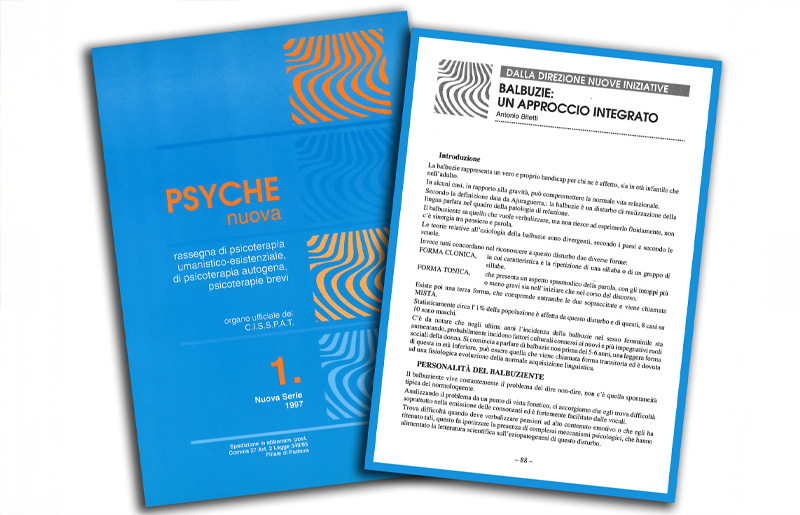
Author: Dr. Antonio Bitetti, psychologist-psychotherapist. Founder of the European Institute for Stuttering. Taken from: Report on: “Stuttering Integrated Approach”, published in 1997, in “PSYCHE nuova”, review of humanistic-existential psychotherapy, autogenic psychotherapy and brief psychotherapies. Official organ of the C.I.S.S.P.A.T of Padua- Italy. The stutterer constantly experiences the problem of saying, not saying, there is not that spontaneity typical of the normally speaking person. Analyzing the problem from a phonetic point of view, we realize that he finds it difficult especially in the emission of consonants, and is greatly facilitated by vowels. He finds it difficult when he has to verbalize thoughts with a high emotional content, or that he has considered as such, this suggests the presence of complex psychological mechanisms, which have fueled the scientific literature on the etiopathogenesis of this disorder. In general case studies, it is found that almost all stutterers stutter in the presence of strangers, or those considered authoritative, emblematic, the example of the child who fears questioning by the teacher. On a relational level, the stutterer feels a prisoner of his disorder and experiences social relationships with difficulty and suffering. For example, he fears verbal exposure in any group relationship, feels discomfort and embarrassment if he is asked to repeat a topic already exposed and his difficult moment is experienced on the phone, which becomes a painful experience and even a real block. This does not mean that all stutterers have social limitations, it depends on the severity and importance that the stutterer gives to his disorder. In fact, a fundamental element is given by the negative perception of oneself and the negative judgment by others, which can increase the level of anxiety, and thus affect normal social relationships. This brief exposition of the difficulties that the adult stutterer experiences, leads us to reflect on the psychic dynamism underlying the disorder. In my vast clinical case history, with more than four thousand cases treated in 25 years of professional activity in Italy, I would like to highlight important contributions of analysis and comparison on this problem. Usually, as a child, the adult stutterer has already undergone cycles of speech therapy and courses on stuttering based mainly on phonation or similar techniques, accompanied by breathing exercises and so on. However, few have addressed the underlying aspects of stuttering and find themselves in adulthood with an unchanged or slightly improved situation, at least in terms of language. Starting from psychoanalytic concepts, stuttering is seen as a symptom of a neurosis with fixation to the sadistic-anal phase. According to Fenichel O., there are traits of strong aggressive valence. The word is life, while mutism is symbolically death and therefore, the alternating speaking, typical of stuttering, can represent the fear of saying things with an aggressive meaning. Behind the zeal of wanting to speak well and to show one’s value is hidden a hostile and sadistic tendency. Stuttering can be seen as a block, and a punishment of this. It is also possible to hypothesize a transfer to the oral level of complex sadistic-anal dynamics. There is a basic ambivalence: on the one hand a wanting to say that can mean action, dynamism and therefore growth. On the other; block, hesitation, which can make one think of the fear of exposing oneself and therefore, passivity. In this, we can glimpse the restorative and creative aspects of the stutterer’s psyche. For a long time, this problem was even joked about, and in very distant times, there was a tendency to associate speech difficulty with intellectual disability. The fluency of language is hindered, but not intelligence and the ability to complete one’s own plans. On a cognitive level, however, the stutterer is constantly influenced by a type of thought, where the fundamental element is the control of the word. The fear of stuttering leads to constant attention on how to say it, on the control in terms of predicting the judgment of others, and finally, on the most realistic and logical one, which is what one wants to say. With such a sequence of thoughts, excessive to say the least, it is easy to fall into a state of anxiety, compromising the speech itself. The normal speaking person does not control the word, it is fluid, he is more attentive to what he says, than to how. This psychic dynamism is certainly affected by counterproductive educational aspects. It is essential to underline in this regard that the obstinacy to correct the disorder, with reprimands from parents or teachers in children or stuttering boys is highly detrimental, and exacerbates the already high level of anxiety.
The Integrated Approach to the Minneapolis Convention (U.S.A)
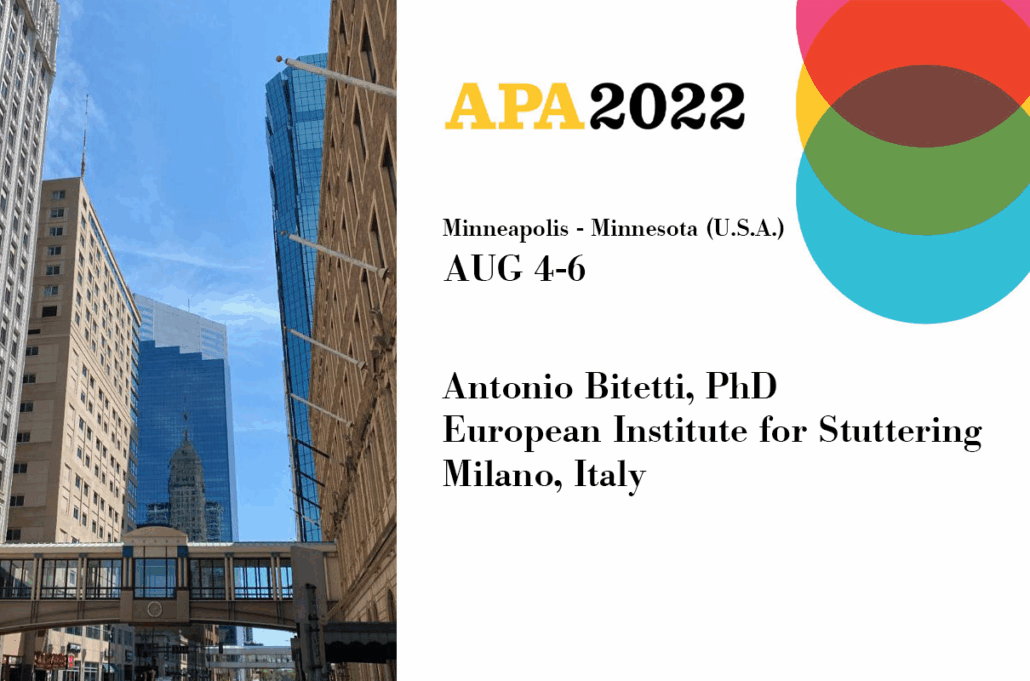
After several years of work and research, Dr. Antonio Bitetti, as an associate member PhD, was invited by his American colleagues from the American Psychological Association (APA), to the annual convention, which this year took place in Minneapolis, Minnesota, from 3 to 6 August 2022. It was a long-awaited and important event, which allowed the aspects of stuttering therapy, in adults and children, contained in the therapeutic model, called: Stuttering Integrated Approach, to be exported to America. He was the only European psychologist present at the event and this makes the work carried out in Italy even more important. An introductory part regarding the interpretation of the problem of stuttering, with comparisons regarding the genetic hypothesis of the problem and/or the relational hypothesis and a descriptive part regarding the actual operational intervention. Dr. Bitetti focused his speech on the relational aspects, since all his research in this sector has always gone in this direction. He emphasized the fundamental element of the control factor, that on the mouth of the stutterer, a real bulwark to be faced, but above all on the tendency of the stutterer to control his emotions, imbued with anger. Finally, much attention and consideration has been aroused by the intervention that Dr. Bitetti carries out in the treatment of preschool children, in the so-called phase of primary or developmental stuttering, 3 and 4-5 years. A true pioneer in Italy and abroad, in a field in which no one had ever ventured before. An exceptional result, for a cutting-edge treatment, in Italy and abroad. https://www.stutteringmeetings.com/wp-content/uploads/2025/07/Dr.-Bitetti-presentation-sub-titles.mp4
The control of the dynamics of stammer
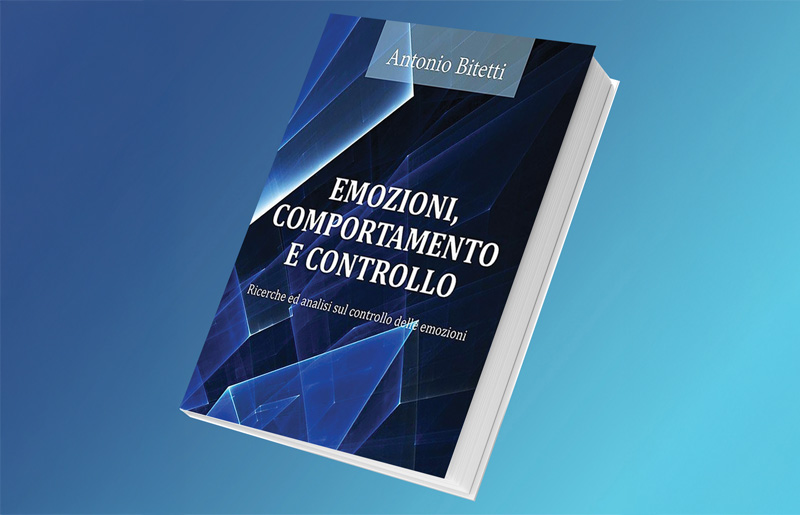
amazon.com/author/antoniobitetti The control of the mouth that I systematically observe in my stammering patients, hides a tendency to retain emotions full of anger and aggressiveness. It is possible to also notice a strong tendency to retain positive emotions, made of joy and a trustful abandonment to life. It seems that the stammerer lives everything in a dimension of strong rigidity, with the propensity to close the energy tap, in the irrational fear of who knows what effects. In the scientific literature about stammer there are no specific studies that link the control mechanism of the phonatory apparatus with the stuttering symptomatology. I have started to talk about that many years ago (Bitetti A,. 2001) and I have continued my research even through a constant job with the model of therapy that I conceived and that I called “Integrated approach” (Bitetti A., 2010). Further research in this direction led me to complete another editorial work titled Emozioni, Comportamento e Controllo (Emotions, Behaviour and Control) in 2016. If I have to define in a practical way what is the problem of stammering, thanks to my twenty-year experience in the sector, I will say, with a certain degree of certainty, that the stammerer stutters because he adopts a psychological strategy that is antithetical to the normal functioning of phonation. It is not easy to say that, even for me that I have been treating stammerers for many years, because it is not easy to think that a control mechanism can be so direct to influence language in such a negative way; but all the evidence at my disposal supports that. Sure enough, every strategy that divert attention from the control over words can rapidly allow the stammerer to express himself normally. The control in stammer is a bad habits learned and kept alive for a long time. We are faced with a wrong learning, but probably adaptative to cope with an experience, considered critical in a given period of childhood. The problem arises when that behaviour is protracted over an extended period, believing that the emergency would last necessarily beyond that time. While the normal speaker, that is the one who do not stammer, never controls his mouth under any circumstances of relational life, the stutterer, on the contrary, massively controls his speech and this affects it negatively. When he is alone, closed in his room, the stammerer never carry out this mechanism of control and so he speaks freely. This happens because this mechanism is strictly connected to the fear of being judged negatively by others, because, highly likely, there is already a negative attitude towards himself.
Description and analysis of the stuttering problem
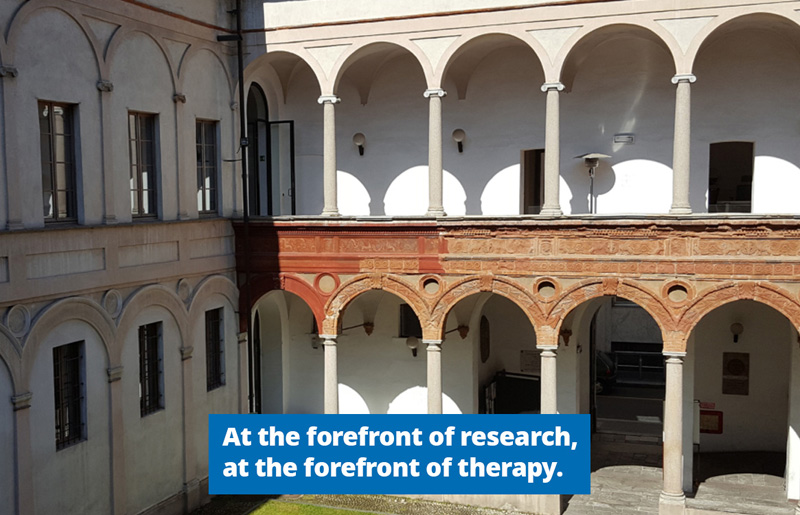
Stuttering affects approximately 1-2% of the population, with a higher incidence in the male sex, out of ten cases of stuttering, eight are certainly male, affecting people from all social backgrounds and in every part of the world. This aspect alone could be an important reason for research in trying to demonstrate the socio-relational value of the disorder or, possible implications of a different order. The stutterer knows what he wants to verbalize but is unable to express it, there is no synergy between thought and word. In the majority of stuttering subjects, for extremely variable reasons, there is a disorganization between thought and language. Too much time passes between what needs to be said and the possibility of saying it. A precise diagnosis of stuttering can only be made when the mechanism has now consolidated in the child’s way and type of communication, that is, when it is: CHRONICIZED. Stuttering, from a strictly symptomatic point of view, consists of a set of alterations in the rhythm and fluidity of verbal expression and is experienced by those who suffer from it with great suffering and discomfort. SOLUTIONS AND INTERVENTIONS PROPOSED ON THE BASIS OF SCIENTIFIC EVIDENCE Currently, there is a substantial contradiction in the therapeutic offer regarding stuttering. In fact, all the phonatory and language re-education techniques, so massively proposed, start from the assumption that this disorder is of language. But in essence this is not the case, because as has already been described, the stutterer in the privacy of his own room, not subjected to the judgment of others, never stutters. It is therefore evident that the stutterer in his heart, knows that he speaks well, but he also knows and would like to explain to everyone, that his real problem is only one of relationship. Supporting the eminently relational matrix of this widespread disorder, it is important to highlight another relevant aspect of this whole dynamic, that is, that the stutterer is also conditioned by the feedback generated by listening to his stuttering. In fact, an important research by the University of Edinburgh produced in the 80s a technological tool that allowed to cancel, through a buzzer, emitted during the emission, the listening of one’s own voice (Edinburgh Masker). This further evidence inevitably leads to the fact that the stutterer is strongly conditioned in his verbal performance, because he tends to suffer the human relationship, rather than manage it in a proactive and productive way. All the dynamism of stuttering translates into a huge waste of potential resources, of missed personal affirmations and that go to impact on the general and above all social dynamism. Sometimes we underestimate the many human resources wasted through useless and sterile attitudes, but we should not continue to close our eyes in the face of such annihilation. The health of a population is the basis of its realization and affirmation, since everyone contributes to this project. The stutterer is also called to this intent and can no longer hide behind this symptom. CULTURAL CRITICALITY AND STUTTERING The criticality is represented above all by the cultural factor. After several decades of re-educational culture, the health world, at various levels, directs patients affected by stuttering towards re-educational or rehabilitative therapeutic solutions, neglecting the many aspects listed above. A culture has been structured over time and in a stereotyped way, it is considered the most suitable, simply because historically it is the one proposed by public health. In all these years, serious research has never been done and this has also facilitated the proliferation of the strangest and most disparate treatment responses, it would be enough to take a look on the internet, to the detriment of the quality and effectiveness of the service offered. There is a need for a cultural and methodological change, but this requires proposals and above all, training that pushes towards a modern vision of the problem. But as we all know, it is not easy to adapt to a new model, especially if it is not supported by statistical evidence and results. Hence the need for widespread experimentation involving the structures already present in the territory, but which have at heart the interest of the population in need of care, the best available in the territory.


